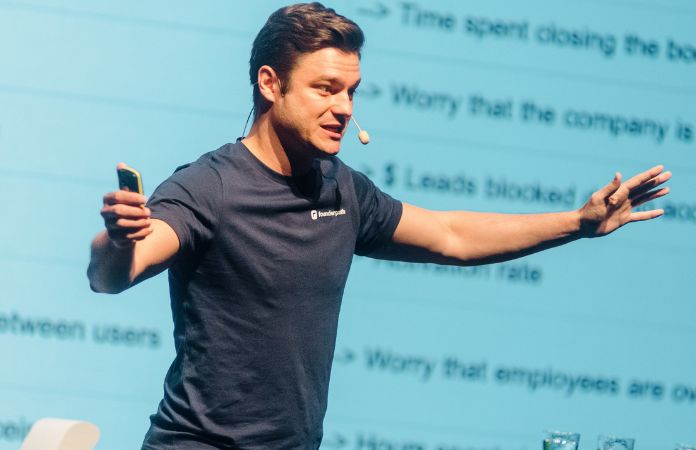Every morning, Nathan Latka spends 15 minutes interviewing successful SaaS founders. Listening to his podcast, you’ll learn all the inside secrets about how SaaS CEO’s launched their startups and turned them into fast-growing SaaS businesses.
At SaaSiest 2022, Nathan’s keynote was the first one out. He shared some of the most valuable insights from what is now more than 2900 episodes of his podcast, and this article sums up the key takeaways.
Reverse-Engineering the Success Journeys of 9 SaaS Unicorns
The question Nathan asked in his keynote was this: How do you build a $100 million ARR SaaS company? He set out to answer that by reverse-engineering what nine different SaaS unicorns have been doing the past few years to get them to where they are today.
Nathan’s talk was packed with actionable advice on how to take a SaaS business to new levels. He focused on nine powerful growth lever, building on real-world examples from his interviews with SaaS founders.
Now, let’s look at each of these levers and how you can try them out in your own context. These growth tactics span from product and development to sales and marketing, so keep reading – here’s something for everyone.
3 Powerful Growth Levers for PRODUCT
SUPERMETRICS: PLG + OPT
PLG+OPT? Well, this is SaaS, so you already knew there’d be a lot of abbreviations. What we’re talking about here is combining Product-Led Growth (PLG) with what Nathan refers to as “Other People’s Traffic” (OPT). A great example of this tactic is Supermetrics, which managed to scale to $10m ARR before they even hired a sales team.
Building their product inside Google’s Workplace as a Google Sheets add-on, Supermetrics effectively leveraged “Other People’s Traffic” and piggybacked on Google’s enormous traction all the way to $100m ARR and beyond.
Tactics to try:
- Leveraging OPT to get your product in front of eyeballs (marketplace, app exchange, chrome store etc.)
- Connecting your product to something that’s already successful and piggyback on an existing audience
- Leveraging PLG instead of hiring sales reps earlier than necessary
RAMP: Hyper Product Velocity
Another way to scale a SaaS business rapidly is to launch new products at high velocity. An example of this growth strategy is Ramp, one of the fastest-growing SaaS companies of all time. They went from 0 to $100m in less than 36 months (which is even faster than Slack grew), and they did this much thanks to an extremely high product velocity. Thanks to solid structures and brave leadership, Ramp is launching a new product every month, and the growth they’ve seen speaks for itself.
Tactics to try:
- Building single-threaded and fully autonomous product-driven teams
- Hold teams ultimately accountable for one single product goal per team
- Setting a structured product cycle rhythm, with yearly and quarterly OKRs feeding into bi-weekly sprints and daily scrums, allowing for a high and reliable launch cadence.
SALESLOFT: Expansion Through Upselling
The third growth lever Nathan discussed within the realm of Product is expansion. It may sound obvious since it’s basic math, but it’s still worth noting that you can never have Net Dollar Retention above 100% if you have nothing to upsell. It’s simply not possible. And whether it’s by selling seats, features, or new products, getting a high NDR is crucial to getting a good valuation.
Nathan cited Kyle Porter from Salesloft, sharing that they’re doing very well at an NDR of 120%. And, as Nathan stresses, when you reach an NDR of 130-140%, that’s when you can get a really good IPO. For reference, the best-in-class publicly traded companies are at an even more impressive 150-160% NDR level.
Tactics to try:
- Prioritize NDR as iäs a crucial factor in SaaS company evaluation
- Sell more than one thing to get an NDR above 100%
- Develop smart product additions to increase your NDR potential
3 Powerful Growth Levers for SALES
ZOOMINFO: Outsourcing Sales Development to Enter New Markets
Breaking into new markets is always a challenge, and one of the hardest ones to conquer is arguably the US. Opening offices in new countries is high-risk and high-cost, so Zoominfo chose a different route when they went across the pond. Instead of hiring their own SDR team, Zoominfo outsourced all sales development. In fact, they didn’t bring in their first SDRs until they’d already reached $50m in ARR.
Tactics to try:
- Outsourcing sales to partners like alleyoop.io or fullfunnel.io
- Not hiring SDRs too early
- Letting AEs book do the hunting and book their own meetings
FUNNEL – Setting the Right Sales Quotas
Setting quotas for your first sales reps is tricky, and in part, quotas depend on what market you’re targeting. But giving sales reps ambitious quotas and making sure they hit them is a critical success factor. Setting the right goals was essential in fast-growing Funnel’s success story, along with the other tactics listed below.
Tactics to try:
- Hiring first sales reps in pairs of one Account Executive and one Account Manager
- Setting quotas at $5k new MRR/month/rep for the first ten sales reps
- Continuously iterating targets to select the optimal quotas
GAINSIGHT: Giving quotas to the Customer Success team
So we’ve talked about outsourcing sales and setting the right quotas, but what about the role of Customer Success? As we all know, churn is the nemesis of SaaS success. In fact, Nathan argues that NDR, not ARR, is the number one valuation driver in SaaS. So how do you reach and maintain a high NDR? Well, asking Gainsight, one of the answers lies in giving the CSM team their own quotas.
Tactics to try:
- Recognizing that NDR is the number one valuation driver
- Giving CSMs a quota to upsell for product expansion
- Giving CSMs a commission when they hit their targets
3 Powerful growth levers for MARKETING
SURFERSEO: Leveraging Affiliates Programs
Affiliate programs are not to be underestimated. One example of this that Nathan cited was SurferSEO, where affiliates drive up to 40% of the total sales. However, an important point Nathan brought up is to always put a clause in your affiliate agreement stating that you have the right to buy back the commission stream by paying a set number of months upfront. This will be an essential lever for your evaluation if you choose to sell the business or bring in VC, enabling you to buy back your margin.
Tactics to try:
- Offering an attractive affiliate program
- Giving affiliates a recurring commission
- Implementing a clause enabling you to buy back the commission stream
WORKATO: Looking at Payback Period Rather Than LTV
Keeping a healthy LTV:CAC ratio is SaaS fundamentals, but Vijay Tella from Workato proposes that there’s another ratio that’s even more important, and that’s CAC in relation to CAC payback period. He argues that while LTV:CAC, in theory, can take forever to pan out, CAC:payback period gives you a more accurate and relevant indicator of success.
Tactics to try:
- Focusing on CAC:payback period over LTV:CAC
- Selling things up-front at the top of your funnel, such as live events and books, and then upsell your software
- Finding new and creative ways to increase money velocity
HUBSPOT: Working With Value-Adding Resellers
Hubspot is a SaaS success story that most people are familiar with. Going back in time and looking at what helped Hubspot become such a giant shows us that at one point in time, 40% of Hubspot’s sales happened through marketing agencies and other partnerships. And those partners would not only sell the software, but they would also go in and help customers implement and leverage the product.
Tactics to try:
- Acquiring platforms where your audiences like to hang out
- Working with agencies or consultants who can both sell you product
- Using the added value of partners to improve the customer experience and keep churn down
Keep Testing and Tinkering
Those were some value-packed 20 minutes Nathan offered us. It became very clear that there are no one-size-fits-all solutions. Many roads can lead to $100 million ARR, and each business needs to find its own. If you want to check out Nathan’s podcast, you’ll find it here, and to learn more about Founderpath, founded by Nathan, visit their website.
Happy SaaS growth!




